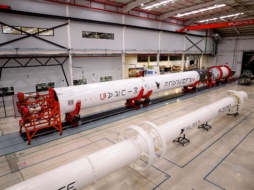Relativity Space CEO Tim Ellis knows what went wrong during Terran 1’s first flight—and he shared with Payload why he is confident the same thing won’t happen to the startup’s Terran R rocket.
In March, Terran 1 became the first 3D printed rocket to reach suborbital space. Though it achieved most of the company’s goals, Ellis shared that the rocket failed to reach orbit due to a problem with the second stage engine’s ignition in the vacuum of space, caused by the ingestion of a gas bubble by the turbo pumps, which are designed to pump liquid, not gas.
This resulted in a phenomenon known as cavitation, leading to a failed startup sequence, Ellis said.
“These are the kind of things that you really do have to fly to get the data. Now that we have the data and have that learning…we will not make the same mistakes,” he told Payload on this week’s Pathfinder podcast. “A lot of the lessons learned are all transportable to [Terran R].”
What’s next: After the failed flight, Relativity announced that it was scrapping Terran 1 development to focus solely on its larger Terran R vehicle.
- Ellis emphasized that this shift is not merely about scaling size, but also better aligning with market demands ($1.8B Terran R pipeline) and the broader vision of the company.
- Overall R&D costs should be in the ballpark of ~$1B, Ellis estimated, adding that it is designed to be reusable from the start and carry 23,500 kg to LEO.
Brand awareness: In an industry dealing with expensive, long-term projects (i.e., space), it’s crucial to inspire and motivate people by focusing on high-effort, creative presentations, Ellis said. The aim is to make Relativity not just a rocket company but a brand that resonates with a broader audience. And music—particularly electronic music—plays a role in the brand’s energy, reflecting Ellis’s personal tastes.
Listen to Pathfinder #0071 for more on Relativity’s future on Mars, whether there’s a rocket larger than Terran R in Relativity’s future, the long-term strategy for 3D printing, and much more.




